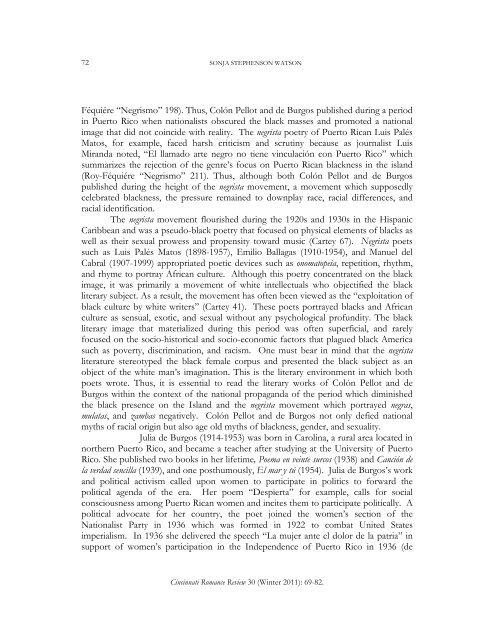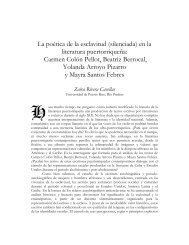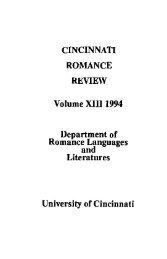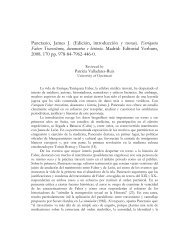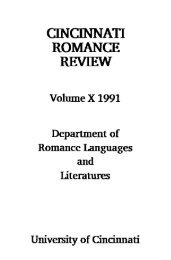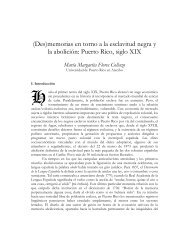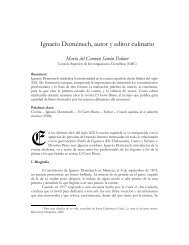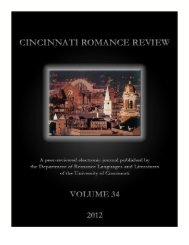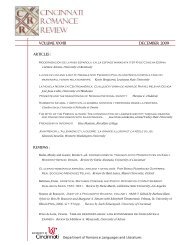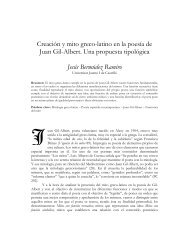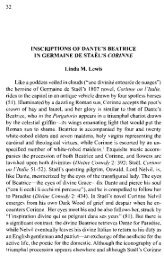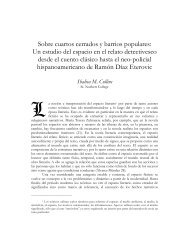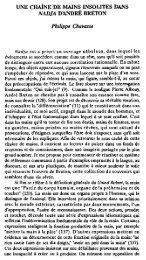Volume 30 (2011) - Cincinnati Romance Review
Volume 30 (2011) - Cincinnati Romance Review
Volume 30 (2011) - Cincinnati Romance Review
You also want an ePaper? Increase the reach of your titles
YUMPU automatically turns print PDFs into web optimized ePapers that Google loves.
72 SONJA STEPHENSON WATSON<br />
Féquiére “Negrismo” 198). Thus, Colón Pellot and de Burgos published during a period<br />
in Puerto Rico when nationalists obscured the black masses and promoted a national<br />
image that did not coincide with reality. The negrista poetry of Puerto Rican Luis Palés<br />
Matos, for example, faced harsh criticism and scrutiny because as journalist Luis<br />
Miranda noted, “El llamado arte negro no tiene vinculación con Puerto Rico” which<br />
summarizes the rejection of the genre’s focus on Puerto Rican blackness in the island<br />
(Roy-Féquiére “Negrismo” 211). Thus, although both Colón Pellot and de Burgos<br />
published during the height of the negrista movement, a movement which supposedly<br />
celebrated blackness, the pressure remained to downplay race, racial differences, and<br />
racial identification.<br />
The negrista movement flourished during the 1920s and 19<strong>30</strong>s in the Hispanic<br />
Caribbean and was a pseudo-black poetry that focused on physical elements of blacks as<br />
well as their sexual prowess and propensity toward music (Cartey 67). Negrista poets<br />
such as Luis Palés Matos (1898-1957), Emilio Ballagas (1910-1954), and Manuel del<br />
Cabral (1907-1999) appropriated poetic devices such as onomatopeia, repetition, rhythm,<br />
and rhyme to portray African culture. Although this poetry concentrated on the black<br />
image, it was primarily a movement of white intellectuals who objectified the black<br />
literary subject. As a result, the movement has often been viewed as the “exploitation of<br />
black culture by white writers” (Cartey 41). These poets portrayed blacks and African<br />
culture as sensual, exotic, and sexual without any psychological profundity. The black<br />
literary image that materialized during this period was often superficial, and rarely<br />
focused on the socio-historical and socio-economic factors that plagued black America<br />
such as poverty, discrimination, and racism. One must bear in mind that the negrista<br />
literature stereotyped the black female corpus and presented the black subject as an<br />
object of the white man’s imagination. This is the literary environment in which both<br />
poets wrote. Thus, it is essential to read the literary works of Colón Pellot and de<br />
Burgos within the context of the national propaganda of the period which diminished<br />
the black presence on the Island and the negrista movement which portrayed negras,<br />
mulatas, and zambas negatively. Colón Pellot and de Burgos not only defied national<br />
myths of racial origin but also age old myths of blackness, gender, and sexuality.<br />
Julia de Burgos (1914-1953) was born in Carolina, a rural area located in<br />
northern Puerto Rico, and became a teacher after studying at the University of Puerto<br />
Rico. She published two books in her lifetime, Poema en veinte surcos (1938) and Canción de<br />
la verdad sencilla (1939), and one posthumously, El mar y tú (1954). Julia de Burgos’s work<br />
and political activism called upon women to participate in politics to forward the<br />
political agenda of the era. Her poem “Despierta” for example, calls for social<br />
consciousness among Puerto Rican women and incites them to participate politically. A<br />
political advocate for her country, the poet joined the women’s section of the<br />
Nationalist Party in 1936 which was formed in 1922 to combat United States<br />
imperialism. In 1936 she delivered the speech “La mujer ante el dolor de la patria” in<br />
support of women’s participation in the Independence of Puerto Rico in 1936 (de<br />
<strong>Cincinnati</strong> <strong>Romance</strong> <strong>Review</strong> <strong>30</strong> (Winter <strong>2011</strong>): 69-82.


